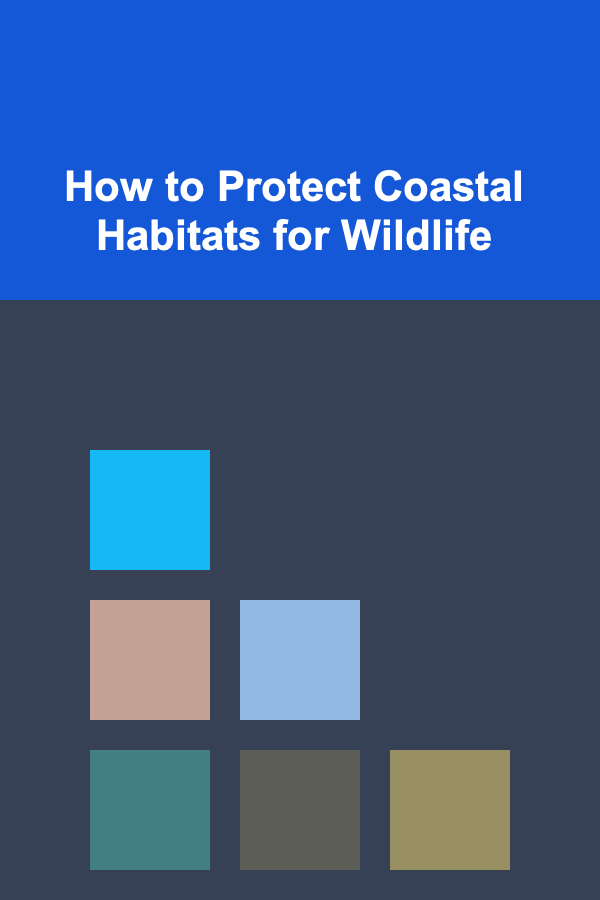
How to Protect Coastal Habitats for Wildlife
ebook include PDF & Audio bundle (Micro Guide)
$12.99$10.99
Limited Time Offer! Order within the next:

Coastal habitats are vital ecosystems that support a wide range of wildlife, provide critical services for human communities, and maintain the overall health of our planet's biosphere. From sandy beaches and tidal flats to salt marshes and coral reefs, these areas are home to an array of species, many of which are endemic or highly specialized. However, coastal habitats are increasingly threatened by human activities such as urbanization, industrial development, pollution, climate change, and overfishing. To safeguard these habitats for future generations of wildlife, it is essential to take immediate and coordinated action.
In this article, we will explore the importance of coastal habitats for wildlife, the primary threats they face, and strategies for their protection. We will also examine the roles of governments, conservation organizations, and local communities in ensuring the preservation of these ecosystems.
Importance of Coastal Habitats for Wildlife
Coastal habitats are among the most biologically productive and diverse ecosystems on Earth. They provide shelter, breeding grounds, and food for many species, some of which rely on these areas for their entire life cycle. For example, sea turtles use sandy beaches for nesting, and migratory birds depend on wetlands and estuaries as stopover sites during long journeys. Furthermore, coastal ecosystems act as buffers against storms and flooding, help maintain water quality, and support a variety of economic activities, including tourism, fishing, and recreation.
Some of the most important coastal habitats for wildlife include:
1. Salt Marshes
Salt marshes are areas of coastal wetlands dominated by salt-tolerant plants. They serve as crucial breeding and feeding grounds for a variety of species, including fish, crabs, and birds. Salt marshes also filter pollutants from water, stabilize shorelines, and act as carbon sinks.
2. Mangroves
Mangrove forests are found in tropical and subtropical coastal areas and are characterized by salt-tolerant trees and shrubs. These ecosystems provide critical habitat for numerous species of fish, invertebrates, and birds. Mangroves also help protect coastal areas from erosion and serve as important nursery grounds for fish species.
3. Coral Reefs
Coral reefs are among the most biodiverse ecosystems on the planet. They provide habitat for countless marine species, including fish, mollusks, and crustaceans. Coral reefs also protect coastal communities by acting as barriers against storms and erosion.
4. Seagrass Meadows
Seagrass meadows are underwater ecosystems found in shallow coastal waters. These meadows support a wide range of marine life, including sea turtles, fish, and invertebrates. Seagrass beds also help improve water quality by trapping sediments and nutrients and by absorbing carbon dioxide.
5. Sandy Beaches
Sandy beaches, while often overlooked, provide essential nesting sites for species such as sea turtles, shorebirds, and crabs. These areas also serve as habitats for many marine invertebrates, which in turn provide food for higher trophic levels.
Each of these ecosystems plays a unique role in supporting biodiversity and maintaining the balance of marine and terrestrial environments. Protecting them is essential not only for the species that depend on them but also for the broader health of the planet.
Threats to Coastal Habitats
Despite their ecological importance, coastal habitats are under threat from a range of human activities. Some of the most significant threats include:
1. Urbanization and Coastal Development
The growing global population has led to increased demand for coastal land for housing, infrastructure, and tourism development. Coastal cities and resorts often result in the destruction or degradation of critical habitats. For example, the construction of seawalls, roads, and buildings can alter natural coastal processes, such as tidal flow, sediment transport, and water quality.
2. Pollution
Coastal areas are vulnerable to various forms of pollution, including plastic waste, oil spills, sewage, and agricultural runoff. These pollutants can harm wildlife by contaminating their habitats, poisoning their food sources, or causing physical damage. For instance, plastics can entangle marine animals or be ingested, leading to injury or death. Agricultural runoff, which often contains pesticides and fertilizers, can lead to eutrophication, causing harmful algal blooms and oxygen depletion in coastal waters.
3. Climate Change
Climate change poses a significant threat to coastal habitats through rising sea levels, ocean acidification, and increased storm frequency and intensity. Rising sea levels can inundate low-lying coastal areas, displacing both human and wildlife populations. Ocean acidification, caused by the absorption of excess carbon dioxide, can weaken coral reefs and disrupt marine food chains. Furthermore, more frequent and intense storms can lead to habitat destruction and degradation, particularly for vulnerable ecosystems like mangroves and salt marshes.
4. Overfishing
Overfishing depletes fish populations and disrupts marine ecosystems. In coastal areas, overfishing can lead to the decline of species that depend on specific habitats, such as seagrass meadows or coral reefs. By removing keystone species, overfishing can alter the structure of coastal ecosystems and reduce biodiversity.
5. Invasive Species
Invasive species, often introduced through human activities, can threaten the balance of coastal ecosystems. These non-native species may outcompete local species for food and space, disrupt ecological processes, and introduce new diseases. For example, the introduction of non-native predators or plants can significantly impact native species and their habitats.
Strategies for Protecting Coastal Habitats
Given the numerous threats facing coastal habitats, it is essential to adopt a multifaceted approach to their protection. The following strategies can help mitigate these threats and ensure the preservation of these vital ecosystems.
1. Establishing Marine Protected Areas (MPAs)
Marine Protected Areas (MPAs) are designated areas where human activities, such as fishing and development, are restricted or prohibited. MPAs provide a safe haven for wildlife, allowing ecosystems to recover and thrive. They are particularly important for protecting sensitive habitats, such as coral reefs, mangroves, and seagrass meadows. Research has shown that MPAs can improve biodiversity, increase fish populations, and enhance the resilience of ecosystems to climate change.
2. Restoring Degraded Habitats
In addition to protecting existing habitats, habitat restoration is an essential strategy for safeguarding coastal ecosystems. Restoration projects aim to rehabilitate degraded habitats, such as mangroves, salt marshes, and coral reefs, by reintroducing native species, removing invasive species, and improving water quality. For example, mangrove restoration can help prevent coastal erosion and provide crucial habitat for marine life.
3. Implementing Sustainable Coastal Development
To minimize the impact of urbanization on coastal habitats, it is essential to implement sustainable development practices. This includes using eco-friendly construction techniques, reducing the footprint of buildings, and incorporating green infrastructure such as mangrove planting and wetlands restoration into urban planning. Zoning laws and land-use regulations can also be employed to protect sensitive areas from development.
4. Reducing Pollution
Efforts to reduce pollution are crucial for protecting coastal habitats. This can be achieved through stricter regulations on industrial discharges, improving waste management systems, and promoting the use of biodegradable materials. Reducing plastic waste is particularly important, as plastic pollution has become a major threat to marine life. Public awareness campaigns and community-driven clean-up efforts can also help address pollution at the local level.
5. Combating Climate Change
To mitigate the impacts of climate change on coastal habitats, it is essential to take global action to reduce greenhouse gas emissions. This includes transitioning to renewable energy, improving energy efficiency, and adopting sustainable agricultural practices. Coastal protection measures, such as the construction of natural barriers like dunes and mangrove forests, can also help protect communities and wildlife from the effects of rising sea levels and extreme weather events.
6. Promoting Sustainable Fisheries Management
Sustainable fisheries management is key to preserving coastal ecosystems and the species that depend on them. This includes implementing quotas, reducing bycatch, and establishing no-fishing zones to protect breeding and nursery grounds. Promoting sustainable fishing practices, such as using environmentally friendly gear and supporting responsible seafood certification programs, can help reduce the negative impact of overfishing.
7. Engaging Local Communities and Stakeholders
Effective coastal habitat protection requires the active involvement of local communities, governments, and stakeholders. Local communities can play a crucial role in monitoring and protecting habitats, as they often have a deep understanding of the local ecosystem. Education and outreach programs can raise awareness about the importance of coastal habitats and encourage sustainable practices. Collaborative efforts between conservation organizations, businesses, and governments can help create policies and initiatives that benefit both wildlife and human communities.
Conclusion
Coastal habitats are indispensable for maintaining biodiversity and the health of our planet. They provide essential services for wildlife, support local economies, and protect coastal communities from the impacts of storms and flooding. However, these habitats are increasingly threatened by human activities such as development, pollution, climate change, and overfishing. To ensure the survival of coastal ecosystems and the wildlife that depends on them, it is crucial to implement effective protection and restoration strategies.
By establishing Marine Protected Areas, restoring degraded habitats, reducing pollution, and promoting sustainable development and fisheries management, we can safeguard these vital ecosystems for future generations. The protection of coastal habitats is not only important for wildlife but also for human well-being, making it a priority for conservationists, policymakers, and communities alike. Through collaborative efforts and continued commitment to coastal conservation, we can create a more sustainable future for both people and wildlife.

How to Budget for Special Occasions and Events
Read More
How to Pack for a Road Trip: A Checklist for the Perfect Drive
Read More
Mastering Content Writing: Essential Skills for Engaging and Persuasive Content
Read More
The Art of Leadership: Essential Skills for Chief Executive Officers
Read More
How to Practice Guided Imagery Meditation
Read More10 Tips for Tracking Progress with a Meditation Planner
Read MoreOther Products

How to Budget for Special Occasions and Events
Read More
How to Pack for a Road Trip: A Checklist for the Perfect Drive
Read More
Mastering Content Writing: Essential Skills for Engaging and Persuasive Content
Read More
The Art of Leadership: Essential Skills for Chief Executive Officers
Read More